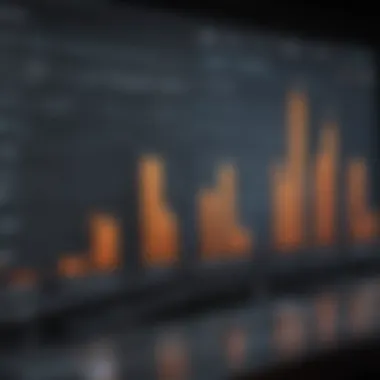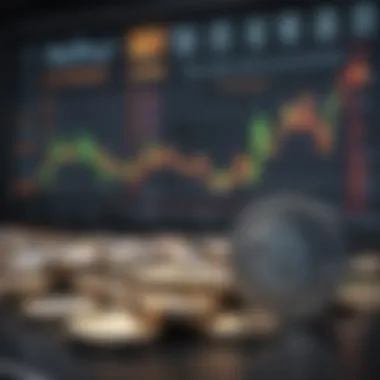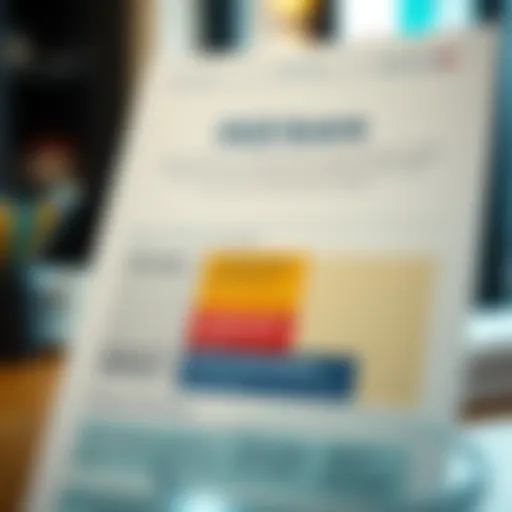Exploring Stock Futures: Trends and Market Impact


Intro
Understanding stock futures can be like cracking a tough nut. It’s not just about buying low and selling high; it's about predicting the future of stock prices based on varying influences. Investors, whether they are just dipping their toes into the financial waters or are seasoned professionals, can benefit from having a solid grasp on this unique investment instrument. Stock futures allow investors to navigate market uncertainties effectively, providing a mechanism for speculation or risk management. This article will provide an in-depth look at the nuances of stock futures, equipping you with the knowledge necessary to leverage these tools thoughtfully.
Key Concepts and Definitions
Overview of Investment Terms
Before we dive deep into stock futures, it’s important to understand a few key terms that often pop up in financial discussions. Here’s a quick rundown:
- Futures Contract: An agreement to buy or sell an asset at a predetermined price at a specified future date.
- Leverage: The use of borrowed money to increase the potential return of an investment.
- Hedging: A strategy used to offset or reduce the risk of price fluctuations in an asset.
Understanding these terms is crucial for navigating the world of stock futures. Each term shapes how investors strategize and execute their trading plans.
Significance of Understanding Financial Terminology
Grasping financial jargon doesn't just give investors an edge; it opens doors to deeper insights. When one knows what terms mean, it allows for more informed decision-making. Imagine trying to follow a recipe without understanding the ingredients—cooking could turn into a disaster. Similarly, in finance, being lost in translation could lead to poor investment choices.
By familiarizing oneself with terms like 'futures contract' and 'hedging', investors can better analyze market conditions and develop tailored strategies that align with their financial goals.
"In the world of stock trading, knowing the difference between a bull and a bear can keep you from being caught upside-down."
Expert Insights and Advice
Investment Strategies for Beginners
Beginners often face the daunting task of choosing the right approach to stock futures. Here are some foundational strategies to consider:
- Start Small: Begin with a limited number of contracts. This helps you learn how the market works without significant financial risk.
- Educate Yourself: Engage with various resources, such as online forums like reddit.com or financial news websites, to broaden your knowledge.
- Practice with Virtual Trading: Many platforms offer virtual trading environments where beginners can gain experience without risking actual cash. This practice is invaluable.
Advanced Techniques for Seasoned Investors
For those who already have a firm grasp on stock directions, the complexity of futures trading can be better utilized through advanced strategies. Such techniques may include:
- Pair Trading: This involves taking long and short positions in closely correlated stocks to exploit inefficiencies.
- Options on Futures: By purchasing an option contract, investors can secure the right but not the obligation to buy or sell the underlying futures contract at a specific price.
- Spread Strategies: Utilizing various spread techniques to manage risk and reduce transaction costs can create more favorable outcomes.
Navigating the landscape of stock futures requires continuous learning and adaptation. The markets are ever-evolving, and strategies that worked yesterday might not be as effective tomorrow.
By deeply understanding the core concepts and developing both basic and advanced strategies, investors can approach stock futures with increased confidence. Let's turn our attention now to how economic indicators and global events can sway the landscape of these financial instruments.
Understanding Stock Futures
The concept of stock futures is pivotal in today's financial landscape. Understanding stock futures helps investors manage their risk, speculate on market movements, and leverage their investments more effectively. In an era where volatility can strike at any moment, having a grasp of what stock futures are and how they operate can be the difference between massive gains and significant losses. With the right knowledge, investors can use these contracts to navigate the ups and downs of the market with finesse.
Definition of Stock Futures
A stock future is a legal contract to buy or sell a specified quantity of an underlying stock at a predetermined price, on a fixed future date. These contracts are traded on exchanges and are standardized in terms of size and expiration dates. It's important to note that stock futures do not imply immediate ownership of the asset; rather, they create an obligation to transact in the future, which introduces a whole new layer of strategy for investors.
The value of a stock future is derived from the underlying stock's market price, and they usually reflect the prevailing sentiment about the stock's future performance. This makes them an essential tool for traders looking to hedge against risks or speculate based on anticipated price movements.
How Stock Futures Work
To understand how stock futures function, consider the following:
- Market Participants: Two main types of participants engage in this market – hedgers and speculators. Hedgers use stock futures to lock in prices and protect their portfolio from adverse price movements. In contrast, speculators aim for profit by betting on which way they believe the stock price will move.
- Contracts and Margin Requirements: When engaging in stock futures, investors place a margin, which is a portion of the total contract value. This allows traders to control larger positions without having to pay the full amount upfront. However, it's worth noting that trading on margin amplifies both potential gains and losses.
- Price Fluctuations: Just like stocks, the price of stock futures fluctuates based on various factors such as market sentiment, economic data, and company performance. Investors need to stay informed about these elements to make well-timed decisions.
- Expiration and Settlement: Stock futures come with expiration dates. As the expiry approaches, the price of the futures contract should converge with the underlying stock price. Upon expiration, contracts can be settled in cash or by delivering the actual underlying stock, depending on the contract specifications.
To sum up, stock futures serve as a complex yet powerful tool in the financial arsenal of investors. By grasping their definitions and workings, one can gain a critical edge in an unpredictable market.
"Knowledge is power, but knowing how to use that knowledge is an art."
Understanding the ins and outs of stock futures is essential for anyone looking to navigate the stock market with confidence.
Key Components of Stock Futures
Understanding the key components of stock futures is essential in navigating the complex landscape of financial markets. These components lay the foundation for how stock futures operate and influence their usage in investment strategies. Let's delve into these crucial elements, focusing on contract specifications and expiration, all while highlighting their significance to investors and traders.


Contract Specifications
Contract specifications serve as the backbone of stock futures trading. Each contract is defined by a set of parameters that dictate its terms, including the underlying asset, quantity, and pricing mechanism. Generally, stock futures contracts specify the following details:
- Underlying Asset: This is the stock or index that the future contract is based on, like the S&P 500 or individual stocks such as Apple or Tesla.
- Contract Size: It establishes the number of shares covered by one futures contract. For instance, one contract often represents 100 shares.
- Price Quotation: Stock futures are quoted in terms of the price at which the contract will be bought or sold. This is usually expressed in dollars per share.
- Settlement Method: The way in which profits or losses are settled. Physical delivery of shares is rare; most trades are cash-settled, making it easier for investors to manage their portfolios without the hassle of transferring actual shares.
The clarity provided by these specifications helps traders not only understand what they are trading but also manage their risk exposure effectively. An in-depth grasp of these elements can elevate a trader's strategy, enabling informed decisions backed by clear parameters rather than guesswork.
Expiration Dates and Rollovers
Expiration dates are a pivotal aspect of stock futures. Each contract has a defined life span, commonly ranging from a few weeks to several months, after which it expires and becomes invalid. The expiration date is crucial because it dictates when a trader must either settle the contract or roll it over to a future date.
Rollover refers to the process of extending the position by closing a futures contract before it expires and simultaneously opening a new one for a later expiration date. It’s an important strategy for traders looking to maintain their exposure without interruption. Here are some considerations:
- Market Timing: Choosing the right moment to roll over can impact profitability. Traders often analyze market conditions before making this move, assessing whether to continue with the same position or adjust their strategy based on market trends.
- Cost Involvement: Rollover can incur costs such as spreads between contracts, and thus financial efficiency is paramount. Traders ought to be mindful of rollover costs as they can erode profits.
- Liquidity Considerations: Closer to the expiration date, liquidity may fluctuate. Traders often prefer to roll over into contracts that maintain higher liquidity, ensuring they don’t get stuck in a position that's difficult to exit.
In sum, both contract specifications and expiration dynamics are indispensable facets of stock futures that every trader ought to understand. They shape not only how contracts are structured but also how positions are managed in the fluid world of trading. Grasping these components can give traders an edge, allowing them to navigate their strategies while balancing opportunity and risk efficiently.
Ultimately, understanding these key components equips investors with the knowledge to leverage stock futures effectively, paving the way for more calculated and confident trading decisions.
By comprehending these intricacies, individuals can harness the potential of stock futures in various market conditions.
Market Dynamics Influencing Stock Futures
Understanding the market dynamics that influence stock futures is crucial for investors aiming to make informed decisions. These dynamics not only shape the prices of futures but also have a significant impact on risk and opportunity within the market. Factors such as supply and demand, economic indicators, and geopolitical events play a pivotal role in determining price movements and volatility in the futures market. By examining these key elements, investors can better navigate the complexities of stock futures trading and develop strategies that align with their investment goals.
Supply and Demand Factors
Supply and demand are foundational concepts that govern not just stock futures but markets in general. When it comes to stock futures, an imbalance in supply and demand can lead to notable price fluctuations.
- High Demand: If many traders are betting on a price increase for a certain stock, demand will outpace supply, leading to higher futures prices. This can happen if investors expect strong earnings reports or positive industry developments related to the underlying stock.
- Low Demand: Conversely, when market sentiment is poor, and traders believe prices will decline, futures prices may drop due to increased selling pressure. This is often exacerbated by broader economic downturns that reduce overall investor confidence.
It's critical to consider the volume of trading in stock futures, as it is often an indicator of market sentiment. A surge in trading volume can suggest that traders are reacting to a specific news event, hence impacting supply and demand dynamics.
Impact of Economic Indicators
Economic indicators serve as vital signposts in guiding investor expectations for stock futures. Generally, positive indicators can boost market confidence, while negative indicators can instill fear. Some commonly watched indicators include:
- Gross Domestic Product (GDP): A robust GDP shows economic growth, often leading to bullish sentiment in stock prices and consequently higher futures prices.
- Unemployment Rates: Rising unemployment can trigger concerns about economic health, prompting many speculators to offload positions and leading futures to decline.
- Inflation Rates: High inflation can erode purchasing power, leading central banks to increase interest rates, which often negatively influences stock prices and futures.
Traders who stay ahead of economic reports can position themselves strategically in the stock futures market to capitalize on anticipated movements. Understanding how these indicators interact with market perceptions is key.
Geopolitical Events and Their Ramifications
Geopolitical events can have sudden and sometimes unforeseen effects on market dynamics, especially in the stock futures realm. Events such as elections, trade negotiations, or military conflicts can shift investor sentiment rapidly.
For instance:
- Elections: A major election can sway markets significantly. If a candidate proposing economic reforms gains traction, futures might reflect optimism about future economic stability.
- Trade Wars: Tariffs and trade agreements can lead to increased volatility. If fears of a trade war escalate, stock futures could plummet as traders anticipate adverse effects on corporate profitability.
- Natural Disasters: Events such as hurricanes or earthquakes can disrupt supply chains, causing certain futures to spike or drop swiftly based on anticipated economic impacts.
In summary, geopolitical uncertainties add layers of complexity to trading strategies. Traders must keep a pulse on world events, as they possess the power to alter market dynamics in the blink of an eye.
Ultimately, navigating the stock futures market demands an astute understanding of these dynamics. Being proactive about supply and demand, economic indicators, and geopolitical situations can make a world of difference in investment outcomes.
Investment Strategies Involving Stock Futures
Investment strategies employing stock futures are crucial for both seasoned investors and newcomers venturing into the financial landscape. Utilizing these futures contracts can provide significant advantages, yet it's imperative to align them with individual financial goals and market conditions. In this section, we will explore the two primary strategies—hedging and speculative trading—while emphasizing their benefits and considerations.
Hedging Techniques
Hedging is akin to putting on a raincoat before stepping outside. It’s about preparation and mitigating risk, especially for those who hold physical stocks. Investors often utilize stock futures to protect their holdings from adverse price movements.
For instance, if an investor owns shares of a technology company and foresees a potential downturn due to an upcoming earnings report, they might take a short position in stock futures. By doing so, if the stock price indeed drops, gains from the futures contract can offset losses from the stocks, stabilizing their overall portfolio.
Here’s a brief overview of common hedging techniques:
- Direct Hedge: This involves taking a position in futures that closely corresponds to the underlying stock’s movement. If the stock drops in value, the futures profit can compensate.
- Cross Hedge: When a direct hedge is impractical, investors may hedge using different but related stock futures. This strategy might not perfectly align, so it comes with additional risks but can still offer some protection.
- Portfolio Hedge: Rather than hedging individual positions, an entire portfolio might be hedged using index futures. This approach provides broader risk coverage and is less labor-intensive.


Adopting hedging techniques is not without challenges. It requires a keen understanding of market dynamics and constant monitoring. Further, transaction costs can accumulate, which could cut into potential gains. Thus, it’s essential to balance the level of protection needed against the costs incurred.
Speculative Trading Approaches
On the flip side, speculative trading presents an opportunity to profit from price movements without owning the underlying assets. It's like trying to catch the wind—challenging yet potentially rewarding. Investors may engage in speculative trading to capitalize on anticipated price changes arising from market trends or economic reports.
Here are some common speculative trading approaches:
- Trend Following: This strategy involves analyzing historical price movements and investing in futures in the direction of the prevailing trend. If a stock's price is on an upward trajectory, a trader might buy futures, betting that the trend will continue.
- Contrarian Trading: Contrarians often go against the grain, buying when others are selling and vice-versa. This method relies heavily on market psychology and requires a thorough analysis of investor behavior to identify potential reversals.
- Swing Trading: This is an intermediate-term strategy where traders buy and hold futures for several days or weeks based on expected price movements. Unlike intraday trading, it allows for capturing larger price swings over time.
While engaging in speculation can be exciting, it comes with its dangers. The leveraged nature of stock futures amplifies potential profits but also losses, meaning a strategy that seems promising can quickly turn sour. Investors must be ready for volatility and should have a well-defined exit strategy.
"Successful investing requires a blend of analytical skills and a gut feeling, but with stock futures, it’s often about timing and understanding the broader market strategy."
Risks Associated with Stock Futures
Understanding the risks tied to stock futures is crucial for anyone looking to navigate this volatile territory. Stock futures are powerful financial instruments, but with power comes responsibility—or, more importantly, risk. Being aware of potential pitfalls can frame strategy and decision-making, making investors far savvier.
Market Volatility Risks
Market volatility can turn the tables for traders, and stock futures are no exception. These financial tools are uniquely positioned to amplify market swings, sometimes wildly. When prices take a nosedive or skyrocket, those holding stock futures can face substantial paper losses. Let’s say a trader locks in a future price for a stock at $100, but unexpected news drops the price to $80. The trader now faces a loss of $20 per contract if they decide to close their position. It’s not just about losing cash; it’s about the emotional rollercoaster that comes along with such fluctuations.
"Market volatility can make the best of us sweat. It keeps us on our toes, that’s for sure!"
However, not all volatility is negative. Some skilled traders thrive in fast-moving markets, leveraging price swings to their advantage. Utilizing protective strategies like stop-loss orders can also provide a safety net, but no strategy is fail-proof. Careful analysis of market conditions before entering or exiting trades is essential for managing this volatility risk responsibly.
Leverage and Margin Requirements
Using leverage in stock futures trading is a double-edged sword. Leverage can magnify gains, allowing investors to control a larger position with a smaller amount of capital. For instance, if a trader utilizes a margin requirement of just 10%, they can trade $1,000 worth of stock futures by only putting down $100. Sounds enticing, right? But, here’s where things can get dicey.
When markets move against a leveraged position, losses can pile up faster than usual due to that same leverage. For example, if a trade goes south and the position drops by 10%, the investor doesn't just lose that percentage. They lose 10% of a larger amount, which can lead to a margin call, forcing the trader to either deposit more cash or liquidate their position at a loss.
- Points to keep in mind:
- Be aware of your broker's margin requirements; they can vary.
- Understand how leverage works before using it—knowledge is key.
- Always have a risk management strategy in place.
It’s vital to approach leverage with caution. What might seem like an opportunity for profit could quickly turn into a recipe for disaster. The allure of higher returns can easily mask the true risks involved, especially for those less experienced in the gritty realities of futures trading.
Being prepared, doing due diligence, and continuously educating oneself about the mechanics of stock futures will serve investors well in navigating both volatility and leverage risks.
Stock Futures vs. Other Financial Instruments
When discussing financial investments, stock futures often come up as a compelling alternative to other instruments such as options and stocks. This section highlights the distinctive characteristics of stock futures in relation to these financial products, offering insights on their significant roles in diversifying portfolios and hedging against risks.
Comparison with Stock Options
Stock options are a popular choice among traders looking to capitalize on price movements without buying the underlying asset outright. They provide the right, but not the obligation, to purchase or sell stock at a predetermined price before a certain date. However, comparing stock options with stock futures sheds light on several key differences.
- Leverage Potential: Stock futures typically offer greater leverage compared to options. In futures trading, investors can control significant amounts of assets with a relatively small margin requirement. This feature can lead to higher returns but also increases the risk of significant losses. On the other hand, options can provide leverage as well, but the potential gains are capped by the option's expiry.
- Loss Considerations: With options, if the market does not move favorably, the most an investor can lose is the premium paid for the option. Futures, however, have no such limitation on potential losses; a dip below the margin requirement can result in a margin call, forcing traders to deposit more funds immediately.
- Time Decay: Options are subject to time decay, meaning their value decreases as they near expiration. Futures contracts, however, do not face this issue in the same way, as their value is tied to the future price of the underlying asset.
Thus, while stock options can offer a layer of flexibility with capped losses, stock futures present a different league of risk-reward dynamics.
Contrasting with Traditional Stocks
Traditional stocks provide ownership in a company and a claim on its assets and earnings. They are often viewed as a long-term investment strategy. Contrasting stock futures with traditional stocks reveals further insights:
- Cost Efficiency: When investing in traditional stocks, investors must pay the full price of the share. Conversely, with stock futures, the initial margin is often a fraction of the total contract value, enabling investors to leverage their capital more effectively.
- Hedging Potential: Investors holding long-term stock positions might use futures contracts to hedge against potential declines in their stock's value. This allows them to balance risks while still holding onto the underlying shares, which is not practical with traditional stock trades.
- Liquidity and Trading Hours: Stock futures are traded around the clock on most futures exchanges. This allows traders to react to market changes quickly. In contrast, traditional stock markets operate within set hours, limiting immediate response to events.
- Market Sentiments: Stock futures can be used to gauge market sentiments before the actual trading begins. The prices of futures can reflect investor expectations about future movements in stock prices, thereby offering a glimpse into market trends.
End
In the landscape of investment instruments, both stock futures and their counterparts like stock options and traditional stocks offer distinct benefits and considerations. Understanding these differences equips investors with the knowledge to make informed decisions tailored to their strategies and risk tolerance.
"In trading, understanding the landscape and the tools at your disposal can set you apart from the pack. Stock futures might just be the vehicle for navigating volatility faster and more efficiently than traditional avenues."
Whether one chooses stock futures for their leverage and flexibility, or opts for the straightforward nature of traditional stocks, it's essential to weigh the pros and cons rooted in one's investment goals.


The Role of Stock Exchanges in Futures Trading
The interaction between stock exchanges and futures trading forms a vital part of the financial ecosystem. Stock exchanges are more than mere marketplaces; they are intricate structures that facilitate the trading of stock futures, contributing significantly to price formation, liquidity, and risk management. Just like a well-oiled machine, the exchanges ensure that buyers and sellers can come together efficiently, enhancing market transparency and promoting investor confidence.
Major Exchanges for Trading Stock Futures
When it comes to trading stock futures, several major exchanges dominate the landscape. These platforms serve as the main hubs for buyers and sellers. The likes of the Chicago Mercantile Exchange and the New York Stock Exchange offer a plethora of products that allow investors to trade futures contracts on various stocks.
- Chicago Mercantile Exchange (CME): A key player known for a broad range of futures products, including stock indices like the S&P 500.
- New York Stock Exchange (NYSE): One of the oldest exchanges that includes several futures contracts linked to various equities.
- Intercontinental Exchange (ICE): Focuses on energy and commodities but also includes stock futures in its product offerings.
- Nasdaq Futures (NFX): Provides a unique range of futures options tied to tech-heavy indices.
These exchanges provide platforms for price discovery and risk management, allowing investors to hedge against price fluctuations or speculate on future price movements.
Regulatory Framework Governing Futures Trading
A robust regulatory framework underpins the functioning of stock futures. Without it, the integrity of the market would be at stake. Regulatory bodies such as the Commodity Futures Trading Commission (CFTC) in the U.S. play an essential role in overseeing trading activities, ensuring transparency, and protecting investors.
The regulatory environment covers various aspects, including:
- Market Surveillance: Monitoring transactions to prevent manipulation and ensure fair pricing.
- Reporting Requirements: Traders often must report their positions, promoting transparency in the markets.
- Leverage Controls: Regulations limit the amount of leverage that can be used in trading, aiming to minimize excessive risk.
The regulations are designed to protect all market participants. They help build trust and stability, encouraging more active participation in the futures market.
Important Note: Navigating the regulatory landscape can be daunting but essential for both novice and veteran investors looking to engage in futures trading. Familiarity with these regulations can be the difference between success and failure.
In summary, understanding the role of stock exchanges and the regulatory framework in futures trading is crucial for navigating the complexities of this financial instrument. Investors must grasp these elements and how they interplay to make informed decisions in the world of stock futures.
Future Trends in Stock Futures Trading
The landscape of stock futures trading is on the brink of evolution, influenced by various factors that include technological advancements and global market dynamics. Understanding these future trends is pivotal as they shape not only trading strategies but also educational platforms for investors. For financial enthusiasts, finding ways to navigate these changes is essential for optimizing their investment outcomes. Let’s break down some of the most significant trends on the horizon, focusing on the elements that might redefine the realm of stock futures.
Technological Advancements in Trading
In recent years, technology has dramatically changed the way trading occurs in financial markets, including stock futures. One of the most noteworthy advancements is the rise of algorithmic trading, which employs complex mathematical models to execute trades at speeds beyond human capabilities. This method enhances efficiency but raises concerns about market manipulation and volatility.
Key considerations include:
- AI and Machine Learning: These technologies can analyze vast data sets faster than any human and make informed decisions based on historical patterns. By employing AI, traders can not only identify trends more accurately but also develop predictive models tailored to their strategies.
- Blockchain Technology: With its decentralized nature, blockchain offers improved transparency and security in trading. This could potentially lead to the elimination of intermediaries, thus reducing costs and enhancing the credibility of transaction histories.
- Mobile Trading Platforms: These platforms have democratized access to stock futures trading. Investors can monitor their portfolios and execute trades from their smartphones, creating an environment where trading decisions are more immediate and informed.
"The rise of technology in futures trading is not just reshaping execution; it's also redefining who can play the game."
Global Market Influences
Market trends are also significantly influenced by global factors, including economic shifts, political changes, and international trade relations. As the world becomes more interconnected, the impact of events in one region can ripple across others.
Some vital influences to watch include:
- Economic Policies and Regulations: Different countries have various monetary policies impacting interest rates, which can, in turn, affect the attractiveness of stock futures in those regions. For instance, a country lowering interest rates might see greater activity in futures as investors seek to hedge against inflation.
- Trade Agreements and Tariffs: International agreements often cause fluctuations in market sentiments. Uncertainty from trade tensions can lead to volatility in stock futures markets, prompting traders to adjust their strategies.
- Geopolitical Events: Political instability or elections in major economies can create uncertainty that impacts stock futures. Traders must be agile, prepared to react to unfolding events that might affect market dynamics.
Finale: The Strategic Importance of Stock Futures
In today’s turbulent financial markets, stock futures play a pivotal role for investors looking to navigate uncertain waters. Essentially, they are agreements to buy or sell shares of a particular stock at a predetermined price on a specific future date. As one delves deeper into stock futures, it becomes clear that their strategic importance extends beyond mere speculation. These instruments can be utilized for effective hedging, allowing investors to protect their portfolios from adverse price movements.
The benefits of employing stock futures are manifold. Let’s explore a few key elements:
- Risk Management: Stock futures can serve as a safety net during market volatility. By enabling investors to lock in prices, they reduce exposure to unforeseen market fluctuations that could otherwise result in substantial losses.
- Leverage Opportunities: Investors can control a larger position with a smaller amount of capital, increasing the potential for returns. However, it’s crucial to understand that this also amplifies potential losses.
- Market Signals: Analyzing stock futures provides insight into market sentiment. For example, high trading volumes in futures could indicate strong investor confidence in specific stocks or sectors.
"Understanding the dynamics of stock futures not only amplifies investment strategies but also enhances the ability to respond decisively to market changes."
Summarizing Key Insights
Throughout our exploration of stock futures, several insights emerge. First and foremost, the interplay between supply and demand significantly influences futures contracts. Economic indicators, including interest rates and employment figures, also play crucial roles in determining market sentiment for stock futures.
- Hedging Needs: Investors are increasingly recognizing the importance of stock futures for hedging positions against the unpredictability of ordinary stock investments. This technique provides a buffer against potential downturns.
- Speculative Appeal: For traders willing to take on risk, the potential for significant profit from stock futures is enticing. The quick turnaround times and high volatility can generate rapid returns, but also, clearly, high risk.
- Regulatory Factors: As stock futures trading grows, so too does the regulatory environment. Staying abreast of changes in regulations is imperative for maintaining the strategic edge.
Final Thoughts on Future Outlook
Looking forward, the landscape of stock futures trading is likely to evolve in tandem with advancements in technology and changes in global markets. The integration of artificial intelligence and machine learning in trading strategies is expected to sharpen analytic capabilities, making it easier to forecast future movements in stock futures with increased accuracy.
Investors should remain vigilant about geopolitical tensions, as these can have profound impacts on stock prices and, consequently, futures contracts. Furthermore, consider the increasing interconnectivity of global markets; trends in one market bubble can ripple across to others, influencing stock futures globally.
In summary, stock futures are an essential tool within the financial toolbox, offering both opportunities and challenges. As the world of finance becomes ever more complex, developing a solid grasp of stock futures and their workings will be invaluable for those wishing to succeed in their investment endeavors.















